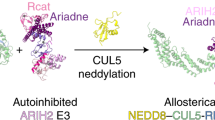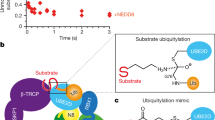Abstract
Protein ubiquitination is a common form of post-translational modification that regulates a broad spectrum of protein substrates in diverse cellular pathways1. Through a three-enzyme (E1–E2–E3) cascade, the attachment of ubiquitin to proteins is catalysed by the E3 ubiquitin ligase, which is best represented by the superfamily of the cullin-RING complexes2,3. Conserved from yeast to human, the DDB1–CUL4–ROC1 complex is a recently identified cullin-RING ubiquitin ligase, which regulates DNA repair4,5,6,7,8,9,10, DNA replication11,12,13,14 and transcription15, and can also be subverted by pathogenic viruses to benefit viral infection16. Lacking a canonical SKP1-like cullin adaptor and a defined substrate recruitment module, how the DDB1–CUL4–ROC1 E3 apparatus is assembled for ubiquitinating various substrates remains unclear. Here we present crystallographic analyses of the virally hijacked form of the human DDB1–CUL4A–ROC1 machinery, which show that DDB1 uses one β-propeller domain for cullin scaffold binding and a variably attached separate double-β-propeller fold for substrate presentation. Through tandem-affinity purification of human DDB1 and CUL4A complexes followed by mass spectrometry analysis, we then identify a novel family of WD40-repeat proteins, which directly bind to the double-propeller fold of DDB1 and serve as the substrate-recruiting module of the E3. Together, our structural and proteomic results reveal the structural mechanisms and molecular logic underlying the assembly and versatility of a new family of cullin-RING E3 complexes.
This is a preview of subscription content, access via your institution
Access options
Subscribe to this journal
Receive 51 print issues and online access
$199.00 per year
only $3.90 per issue
Buy this article
- Purchase on Springer Link
- Instant access to full article PDF
Prices may be subject to local taxes which are calculated during checkout



Similar content being viewed by others
References
Hershko, A. & Ciechanover, A. The ubiquitin system. Annu. Rev. Biochem. 67, 425–479 (1998)
Pickart, C. M. Mechanisms underlying ubiquitination. Annu. Rev. Biochem. 70, 503–533 (2001)
Petroski, M. D. & Deshaies, R. J. Function and regulation of cullin-RING ubiquitin ligases. Nature Rev. Mol. Cell Biol. 6, 9–20 (2005)
Nag, A., Bondar, T., Shiv, S. & Raychaudhuri, P. The xeroderma pigmentosum group E gene product DDB2 is a specific target of cullin 4A in mammalian cells. Mol. Cell. Biol. 21, 6738–6747 (2001)
Chen, X., Zhang, Y., Douglas, L. & Zhou, P. UV-damaged DNA-binding proteins are targets of CUL-4A-mediated ubiquitination and degradation. J. Biol. Chem. 276, 48175–48182 (2001)
Sugasawa, K. et al. UV-induced ubiquitylation of XPC protein mediated by UV-DDB-ubiquitin ligase complex. Cell 121, 387–400 (2005)
Groisman, R. et al. CSA-dependent degradation of CSB by the ubiquitin–proteasome pathway establishes a link between complementation factors of the Cockayne syndrome. Genes Dev. 20, 1429–1434 (2006)
Groisman, R. et al. The ubiquitin ligase activity in the DDB2 and CSA complexes is differentially regulated by the COP9 signalosome in response to DNA damage. Cell 113, 357–367 (2003)
Kapetanaki, M. G. et al. The DDB1–CUL4ADDB2 ubiquitin ligase is deficient in xeroderma pigmentosum group E and targets histone H2A at UV-damaged DNA sites. Proc. Natl Acad. Sci. USA 103, 2588–2593 (2006)
Wang, H. et al. Histone H3 and H4 ubiquitylation by the CUL4–DDB–ROC1 ubiquitin ligase facilitates cellular response to DNA damage. Mol. Cell 22, 383–394 (2006)
Liu, C. et al. Cop9/signalosome subunits and Pcu4 regulate ribonucleotide reductase by both checkpoint-dependent and -independent mechanisms. Genes Dev. 17, 1130–1140 (2003)
Higa, L. A., Mihaylov, I. S., Banks, D. P., Zheng, J. & Zhang, H. Radiation-mediated proteolysis of CDT1 by CUL4–ROC1 and CSN complexes constitutes a new checkpoint. Nature Cell Biol. 5, 1008–1015 (2003)
Hu, J., McCall, C. M., Ohta, T. & Xiong, Y. Targeted ubiquitination of CDT1 by the DDB1–CUL4A–ROC1 ligase in response to DNA damage. Nature Cell Biol. 6, 1003–1009 (2004)
Bondar, T., Ponomarev, A. & Raychaudhuri, P. Ddb1 is required for the proteolysis of the Schizosaccharomyces pombe replication inhibitor Spd1 during S phase and after DNA damage. J. Biol. Chem. 279, 9937–9943 (2004)
Wertz, I. E. et al. Human De-etiolated-1 regulates c-Jun by assembling a CUL4A ubiquitin ligase. Science 303, 1371–1374 (2004)
Horvath, C. M. Weapons of STAT destruction. Interferon evasion by paramyxovirus V protein. Eur. J. Biochem. 271, 4621–4628 (2004)
Li, T., Chen, X., Garbutt, K. C., Zhou, P. & Zheng, N. Structure of DDB1 in complex with a paramyxovirus V protein: viral hijack of a propeller cluster in ubiquitin ligase. Cell 124, 105–117 (2006)
Zheng, N. et al. Structure of the Cul1–Rbx1–Skp1–F boxSkp2 SCF ubiquitin ligase complex. Nature 416, 703–709 (2002)
Liu, C. et al. Transactivation of Schizosaccharomyces pombe cdt2+ stimulates a Pcu4–Ddb1–CSN ubiquitin ligase. EMBO J. 24, 3940–3951 (2005)
Angers, S. et al. The KLHL12–Cullin-3 ubiquitin ligase negatively regulates the Wnt–β-catenin pathway by targeting Dishevelled for degradation. Nature Cell Biol. 8, 348–357 (2006)
Lambright, D. G. et al. The 2.0 Å crystal structure of a heterotrimeric G protein. Nature 379, 311–319 (1996)
Wall, M. A. et al. The structure of the G protein heterotrimer Giα1β1γ2 . Cell 83, 1047–1058 (1995)
Shiyanov, P. et al. The naturally occurring mutants of DDB are impaired in stimulating nuclear import of the p125 subunit and E2F1-activated transcription. Mol. Cell. Biol. 19, 4935–4943 (1999)
Li, F. et al. Two novel proteins, dos1 and dos2, interact with rik1 to regulate heterochromatic RNA interference and histone modification. Curr. Biol. 15, 1448–1457 (2005)
Thon, G. et al. The Clr7 and Clr8 directionality factors and the Pcu4 cullin mediate heterochromatin formation in the fission yeast Schizosaccharomyces pombe. Genetics 171, 1583–1595 (2005)
Leupin, O., Bontron, S. & Strubin, M. Hepatitis B virus X protein and simian virus 5 V protein exhibit similar UV-DDB1 binding properties to mediate distinct activities. J. Virol. 77, 6274–6283 (2003)
Acknowledgements
We thank the beamline staff of the Advanced Light Source at Berkeley for help with data collection, P. Zhou, W. Xu, J. Beavo, Z. Gao and members of the Zheng and Moon laboratories for discussions and help. We also thank J. W. Harper and Y. Xiong for communicating unpublished results. This work is supported by grants from the National Institutes of Health (to N.Z. and M.J.M.), the Pew Scholar Program (N.Z.), and the Howard Hughes Medical Institute (S.A. and R.T.M.). Author Contributions S.A. and T.L. contributed equally to this work.
Author information
Authors and Affiliations
Corresponding authors
Ethics declarations
Competing interests
Structure coordinates for the DDB1–CUL4A–ROC1–SV5-V complex have been deposited in the Protein Data Bank under accession number 2HYE. Reprints and permissions information is available at www.nature.com/reprints. The authors declare no competing financial interests.
Supplementary information
Supplementary Notes
This file contains Supplementary Tables 1–3 showing detailed crystallographic and proteomic results, and Supplementary Figures 1–5 describing more structural and co-affinity interaction analyses. (PDF 1250 kb)
Rights and permissions
About this article
Cite this article
Angers, S., Li, T., Yi, X. et al. Molecular architecture and assembly of the DDB1–CUL4A ubiquitin ligase machinery. Nature 443, 590–593 (2006). https://doi.org/10.1038/nature05175
Received:
Accepted:
Issue Date:
DOI: https://doi.org/10.1038/nature05175
This article is cited by
-
Centrosome amplification and aneuploidy driven by the HIV-1-induced Vpr•VprBP•Plk4 complex in CD4+ T cells
Nature Communications (2024)
-
Targeting DCAF5 suppresses SMARCB1-mutant cancer by stabilizing SWI/SNF
Nature (2024)
-
Novel, thalidomide-like, non-cereblon binding drug tetrafluorobornylphthalimide mitigates inflammation and brain injury
Journal of Biomedical Science (2023)
-
The interactions between PML nuclear bodies and small and medium size DNA viruses
Virology Journal (2023)
-
Activity-based profiling of cullin–RING E3 networks by conformation-specific probes
Nature Chemical Biology (2023)
Comments
By submitting a comment you agree to abide by our Terms and Community Guidelines. If you find something abusive or that does not comply with our terms or guidelines please flag it as inappropriate.



